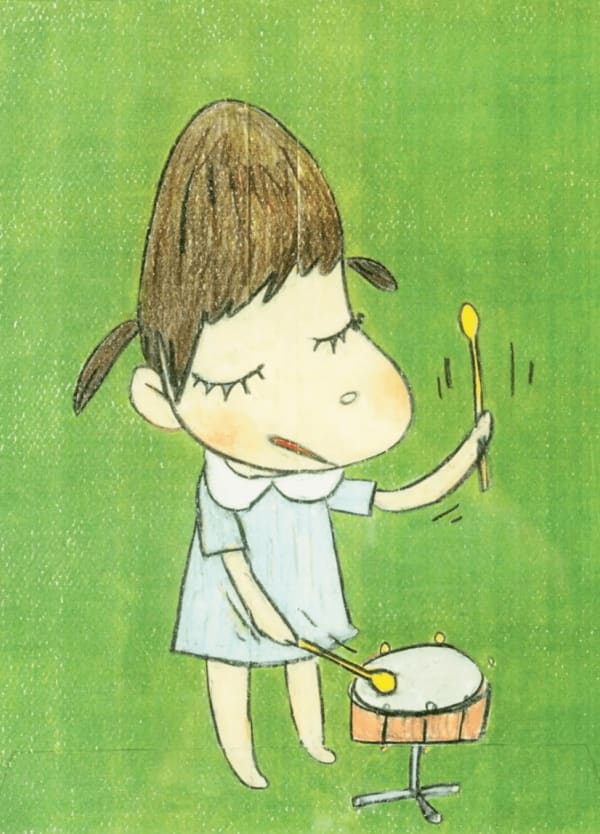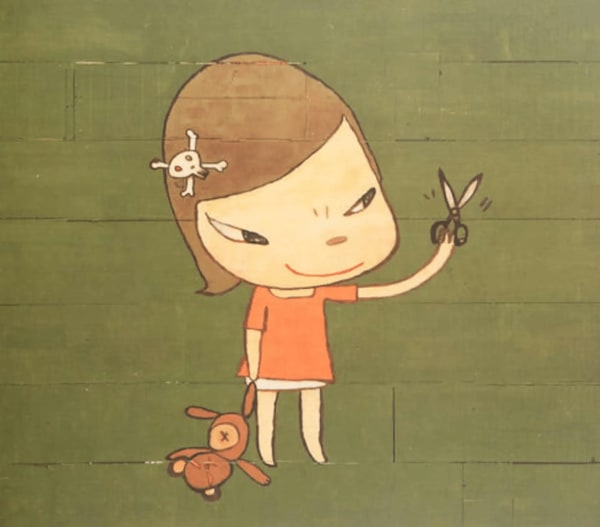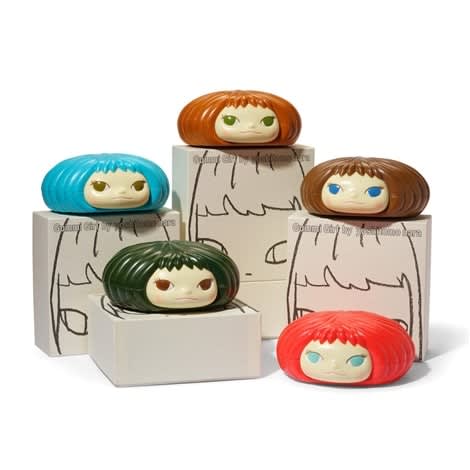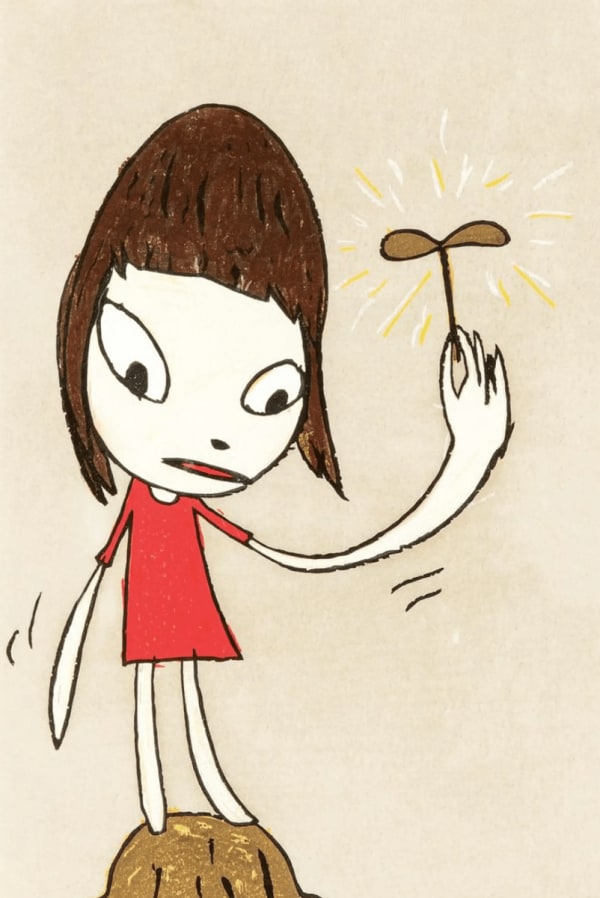-
Yoshitomo Nara's expressive cartoon children have seen the pioneering artist rise to global acclaim and fame communicating complex emotion whilst celebrating the freedom of the imagination and the indvidual. Discover our selection of Yoshitomo Nara PRINTS for sale at Guy Hepner, Nara dealers since 2012.
-
New In: Yoshitomo Nara Prints For Sale
-
 Yoshitomo NaraBanging The Drum, 2002
Yoshitomo NaraBanging The Drum, 2002 -
 Yoshitomo NaraCosmic Girl Eyes Closed, 2008
Yoshitomo NaraCosmic Girl Eyes Closed, 2008 -
 Yoshitomo NaraIn the clouds, 2003
Yoshitomo NaraIn the clouds, 2003 -
 Yoshitomo NaraMarching On A Butterbur Leaf, 2019
Yoshitomo NaraMarching On A Butterbur Leaf, 2019 -
 Yoshitomo NaraThe Real One, 2019
Yoshitomo NaraThe Real One, 2019 -
 Yoshitomo NaraGummi Girl (Set of 5), 2006
Yoshitomo NaraGummi Girl (Set of 5), 2006 -
 Yoshitomo NaraMy Little Treasure, 2010
Yoshitomo NaraMy Little Treasure, 2010 -
 Yoshitomo NaraFuckin' Politics, 2003
Yoshitomo NaraFuckin' Politics, 2003
-
-
Series

Yoshitomo Nara
Sleepless Night (Sitting), 2007Mixed media sculpture11 3/4 x 6 1/4 in
30 x 16 cmEdition of 300Series: 2007Copyright The ArtistYoshitomo Nara’s work is characterized by his signature style of portraying youthful figures with oversized heads and large, expressive eyes. These characters, often solitary or set against minimalistic backdrops, radiate...Yoshitomo Nara’s work is characterized by his signature style of portraying youthful figures with oversized heads and large, expressive eyes. These characters, often solitary or set against minimalistic backdrops, radiate a combination of innocence, defiance, and vulnerability. Nara’s aesthetic merges elements of Japanese pop culture, manga, and anime with influences from Western punk rock and art history, creating a unique visual language. The simplicity of his compositions belies the emotional depth within his work, where themes of loneliness, rebellion, and existential reflection resonate universally.
Nara’s legacy is closely tied to the global popularity of contemporary Japanese art, and he is regarded as a leading figure of the Superflat movement spearheaded by Takashi Murakami. Unlike the polished, commercial feel often associated with the movement, Nara’s art carries a deeply personal, introspective quality that has endeared it to audiences worldwide. His pieces speak to both collective and individual emotions, making his work feel accessible yet profound. From paintings and drawings to sculptures and installations, Nara’s versatile practice has cemented his place as one of Japan’s most influential contemporary artists.
Culturally, Nara’s work serves as a bridge between Japan’s postwar experiences and its vibrant, pop-culture-driven present. His art reflects the struggles and resilience of a generation growing up amidst rapid social and economic change. The defiant gaze of his characters, often paired with provocative text, speaks to the enduring spirit of youth and its power to question authority and norms. At the same time, his work captures a timeless vulnerability, offering a poignant commentary on universal human experiences like isolation, longing, and connection.
The impact of Nara’s art extends beyond galleries and museums, permeating popular culture and inspiring fans and collectors globally. His work has become a cultural icon, emblematic of contemporary Japanese art’s ability to blend the personal with the universal. Nara’s practice continues to influence a new generation of artists, ensuring his enduring relevance in the art world while fostering a deeper appreciation for the interplay of tradition and modernity in Japanese culture.
Overview"Even if I knew there would be no one out there to look at my work, I would still make the exact same thing."
Yoshitomo Nara creates a fairytale world that is at once both inviting and calming yet tense and mysterious. Classically trained in Germany and in Japan, the artist going on to merge and blend these seemingly disparate schools throughout his career, Nara forgoes an intellectual and philosophical approach to his art communicating emotion in the purest form. Pushing back at what he sees as “aloofness of high art” Nara’s commitment to engaging in accessible, mass-produced imagery and the repetition of his characters recalls Warhol’s repetition of brands and celebrities.
The characters take on a new dimension for many viewers as they become the blank canvases themselves for us to project parts of ourselves onto. This strong bond that collectors feel towards the characters in Nara’s artworks, his deft and sensitive treatment of emotion, place and object (the artist's love of punk and rebellion appearing in guitars) invites introspection causing us to examine both ourselves and the scenes in front of us. Nara's characters are strong little personalities who are ready to rebel as we are presented with snapshots of their lives. The big-eyes girls, Napo, the Dog and Miss Margaret defy the adult world and reveal their opinions with the honesty that is unique to children
Nara's prints and paintings delve into the deepest parts of his soul, emerging through a painstaking process of layering and erasing color. Guided by painting theory, he pares his compositions down to their most sincere essence. In contrast, his drawings are raw and spontaneous, created on familiar materials like torn paper or used envelopes. These works reveal unfiltered emotions and thoughts. His three-dimensional sculptures, crafted in various media, breathe new life into familiar forms through a reflective engagement with materials. In recent years, Nara has also embraced photography, capturing the overlooked beauty of everyday landscapes and moments from his travels with a sense of quiet reverence.
Nara draws inspiration from numerous sources from past and contemporary culture. He has great respect for doga, a Japanese style of children’s book illustrations that appeals to an adult audience as well by providing social commentary and layered meaning for an adult viewer to unpack
Yoshitomo Nara’s prints are an expression of pure emotion, of embracing the innocence and possibilities of childhood through their delicately and poised imagery and text. At Guy Hepner, we have assisted collectors across the globe to buy Yoshitomo Nara prints and enter into his rich, fairytale-like world. Whether new to collecting Yoshitomo Nara prints, or an experienced collector, our knowledge and experienced team can help you. For further information on our available Yoshitomo Nara prints for sale, contact info@guyhepner.com










